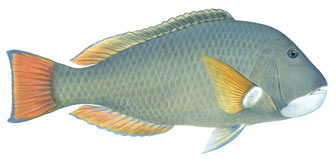
The baldchin groper (Choerodon rubescens) is endemic to Western Australia, meaning it’s not found anywhere else in the world. It’s a member of the Labridae or wrasse family. It can be identified by the white patch on its pectoral (side) fin and white chin. Prized for its high-quality white flesh, the baldchin groper is a target for both recreational and commercial fishers.
One of the largest species of tuskfish, it has protruding tusk-like teeth in both jaws and can reach about 90 cm in length and 7 kg in weight.
They are slow-growing fish and take five to seven years to reach 40 cm in length. As a result, baldchin groper stocks are likely to take a long time to recover from sustained overfishing.
Baldchin
groper do not travel far, making it easy for fishers to find them, and using
GPS (global positioning system) technology, record the spot and return another
time. Occasionally this species has been observed to ‘aggregate’ (gather in
large groups) to ‘spawn’ (release sperm and eggs). At these times, they may
also be vulnerable to high levels of fishing.
The baldchin groper is an ‘indicator species’ in the Mid-West area of the West Coast Bioregion. This means its stock status is used to indicate the status of baldchin groper in the Mid-West area. As such, it plays an important part in the sustainable management of fisheries in WA.
Distribution and habitat
Baldchin groper are only found between Coral Bay and Cape Naturaliste. They are most abundant at the Abrolhos Islands, 60 kilometres west of Geraldton.
They are inshore, demersal fish, which means they live close to shore, to depths of 20-250 m, and close to the seabed. They live mostly around reefs less than 100 m deep. Juveniles are often found in shallow weedy areas near reef.
Illustration © R. Swainston/www.anima.net.au